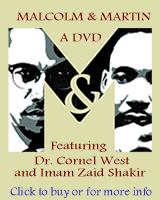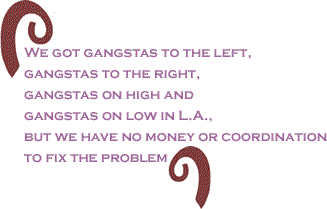
|
|||||||||||||||||||||
 |
|||||||||||||||||||||
 |
|||||||||||||||||||||
 |
|||||||||||||||||||||
 |
|
The Los Angeles City Council’s Ad Hoc Committee On Gang Violence and Youth Development got a chance to hear a gang study last week, that finally undressed “the Emperor.” But those of us in the streets of Los Angeles have known, for some time, that the Emperor was butt-naked. The city’s gang intervention efforts have long been a paper tiger, with no teeth, no roar and no real resources to make a difference in the nation’s most volatile gang setting. However, it was never been put as plainly and succinctly as the Advancement Project’s Connie Rice brought it last week. She “blew the committee’s cap back,” (as the boyz in the hood like to say). It wasn’t pretty, but it needed to be said. Los Angeles has abandoned youth development over the past three decades, and left youth in the street to fend for themselves. The results have been the formation of 720 gangs and close to 40,000 bangers that the city tries to handle with sixty-one interventionists. And they wonder why gang violence was up 14% while crime throughout the city was down. Try that more than half of the homicides in the city (56%) were gang-related and 75% of the youth gang homicides in the state were in Los Angeles County, largely due to this under-resourcing. It’s not that the money isn’t there. Most of the city’s $82 million dollars goes into the administrative costs of 23 anti-gang programs that never even talk to each other. It was never enough to begin with, but it’s even less when it’s not getting to where it was supposed to go, to the youth in the streets. L.A. threw pennies at prevention, and dollars at suppression. Now L.A.’s going to pay a pound (a billion dollars over the next 18 months) to cure it. And it should. That’s what the study called for, and it’s really the cost of being negligent. What will now become known as “the Rice Report,” commissioned by the city a year ago to give teeth to a new department proposed by former city councilman Martin Ludlow, the study is now the blueprint for exposing government waste, lack of coordination, and making a commitment to youth development in this city. The report, which was previewed at the Urban Issues Forum of Greater Los Angeles in November, 2006, stated that Los Angeles is the most under-resourced “Big City” in America when it comes to resources invested in youth violence prevention, gang intervention and alternative programming to divert youth out of the juvenile justice and criminal justice systems. Los Angeles, the signature “Hollywood” town of glitz and glamour—where “show biz” rules (emphasis on “show”)—puts nowhere near the money in youth development, gang prevention and intervention, and diversion programs (including job training and the arts) that New York and Chicago invest. L.A. is experiencing unprecedented class conflict that has manifested itself into a resurgence of gang violence that has gone on for 20 years as well as racial conflict to which the city leaders claimed they don't have answers. This has happened largely because they have long ignored the people with the answers and always avoided “the money questions”, as if putting money in meaningful social programs was always some grand plot to get into the pockets of the taxpayers, as part and parcel to the 1970s Prop. 13 tax revolt that robbed cities of the ability to manage social growth. As a result, Los Angeles (and California) has ignored education, highway infra-structure, the arts and mostly critically, youth development because there was, supposedly, no money. And it’s finding out, in its economic divide (more millionaires, more people living in poverty, more homeless live in L.A. than anywhere in the country), that the city is suffering from that old adage; “You make not always pay for what you get, but you always get for what you pay for.”
Los Angeles’ divestment in human capital has stripped its youth of their humanity. A few days after Connie Rice made her presentation, Princeton Professor, Cornel West appeared at the 15th Anniversary of the Senator Mark Ridley-Thomas’ Empowerment Congress, stating that we have to ask ourselves what does it mean to be a person? Los Angeles has de-humanized its youth in a way that has robbed them of the options of violence protection, vocation and training that prior generations had, and has, instead, fed the prison industrial complex for the past 20 years. California has the largest prison system in the nation with 172,000 prisoners—mostly those who have come out of the inner cities, where they had no alternatives to street life. Governor Schwarzenegger recently proposed another billion dollars to build new prisons, while the California legislature proposed new prison release guidelines to reduce prison overcrowding (under threat of federal intervention, mind you). What are they going to provide people when they let them out? Professor West reminded us that if we’re going to have a conversation about gangsterism, we have to keep track of the “gangstas in high places.” In L.A., that means the politicians and the po’lice. The absence of the political will to fund gang prevention and intervention programs while funding damn near anything that LAPD has asked for shows that those trying to do the intervention work in the streets have gotten “straight gangstered” over the years. The police, of course, have engaged in the kind of gangstering that brought about the nation’s largest police department scandal (Rampart), racial profiling of another kind, and a blue code system that protects its officers in disciplinary processes that are as bogus as the justifications they use to beat and/or shoot unarmed citizens (including children). We got gangstas to the left, gangstas to the right, gangstas on high and gangstas on low in L.A., but we have no money or coordination to fix the problem. We now know that the problem of stopping gang violence isn’t just in the streets. And the city still doesn’t have all the answers they need to solve this crisis. But, as of last week, the city has a better picture of what the reality of the under-resourcing has caused and what they need to do to fix it.
Rice’s call for a “Marshall Plan” to rebuild the humanity of our youth through reinvestment of human capital is timely and appropriate. Now the ball is in the City’s court to make the right investment. We’ll see soon if Los Angeles really wants to solve its gang crisis. BC Columnist Anthony Asadullah Samad is a national columnist, managing director of the Urban Issues Forum and author of 50 Years After Brown: The State of Black Equality In America. His website is AnthonySamad.com. Click here to contact Mr. Samad. |
|
| Home | |
| January 25, 2007 Issue 214 |
||||||||||||||
|
||||||||||||||
| Printer Friendly Version in resizeable plain text format | ||||||||||||||
 |
||||||||||||||
|
||||||||||||||
 |
||||||||||||||
 |
||||||||||||||
 |
||||||||||||||
 |
||||||||||||||
| |
||||||||||||||
| |
||||||||||||||






























